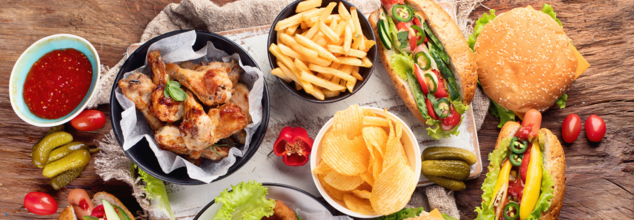- Health Conditions A-Z
- Health & Wellness
- Nutrition
- Fitness
- Health News
- Ayurveda
- Videos
- Medicine A-Z
- Parenting
Why Ozempic Might Be Making Your Favorite Foods Taste Gross?

Credits: Canva
For decades, food has not only been an important source of nutrition but also of emotion and culture. It's the way we share ourselves, celebrate, and find solace. But what occurs when food starts to lose its appeal? For a lot of people on mainstream weight-loss drugs such as Ozempic and Wegovy, this has become a very personal and physiological challenge. One of the most fascinating and sometimes disturbing—side effects noted is a stark dislike of once-loved foods, especially meat and fried foods. Why?
As weight-loss drugs like Ozempic (semaglutide) and its alternative Wegovy become more popular, so too are first-person accounts of changed taste and appetite. Though these drugs are praised for their ability to control weight, users are now reporting an unexpected change in how they feel about food—one that science is just starting to completely grasp.
Ozempic is a GLP-1 receptor agonist that was first developed to treat type 2 diabetes. Its cousin, Wegovy, has the same active ingredient—semaglutide—but with the specific approval from the FDA for weight reduction. Both of these medications copy a hormone called GLP-1 (glucagon-like peptide-1), which the body naturally secretes from the gut in reaction to food. When the drug binds to the GLP-1 receptors of the brain and body, the medication assists with maintaining blood sugar levels, slowing down gastric emptying, and curbing appetite.
But scientists now believe its impacts extend well past the ability to make individuals full. GLP-1 receptors also occur within regions of the brain used to process rewards as well as human taste buds. This dual influence—upon taste and appetite—may account for the reason so many users can find themselves in disgust at eating foods that before they enjoyed highly.
Former Minnesota food reporter Alyssa Fraser gives a powerful illustration. A once enthusiastic home cook who loved to prepare her go-to chicken and vegetable recipes, she found herself no longer liking those same dishes after beginning Wegovy. Finding meat to taste like the "barnyard" it originated from and wine strangely "vegetal," Fraser didn't just lose her appetite but underwent a shift in sense perception.
This experience is not singular. Countless individuals online on forums as well as medical research have noted the same issues—meat too pungent, foods fried too weighty, even desserts losing desire after a mouthful or two. In several instances, meals are no longer an enjoyment, but rather become more of an instrumental necessity.
Is the Brain Rewiring Its Cravings?
Psychobiologists have proposed that GLP-1 medications induce a decoupling between "liking" and "wanting" food. In daily life, individuals tend to keep consuming calorie-rich foods even if they don't like them, motivated by habit or emotional reward. GLP-1 agonists seem to break this cycle by suppressing the brain's dopamine-mediated "wanting" response, allowing for easier resistance to indulgent foods.
In a way, your brain is being re-conditioned not to pursue the sensory high of food—especially from sugar, salt, and fat. This may be one of the reasons why greasy, fried, and heavy foods now feel too much or even disgusting.
While much of the existing data is reliant on self-reporting, increasingly studies are starting to investigate these effects in more systematic ways. One source, published in Food Quality and Preference, discovered that individuals taking GLP-1 drugs ate less refined grains, red meat, and sweets compared to controls. They also ate more fruit, more leafy greens, and drank more water—gravitating toward a naturally healthier diet, even with no deliberate intention.
But much of this evidence is based on small groups or animal studies. University of Arkansas professor of food policy economics Brandon McFadden cautions that self-reporting can be sketchy. But the trend is unmistakable: individuals taking these drugs take in fewer calories—sometimes as many as 700 fewer a day—primarily because food is less appealing.
Another study presented at the Endocrine Society's 2024 conference provided some neurological insight. Brain scans of women on semaglutide showed increased activity in areas related to taste processing, particularly in response to sweet stimuli. This suggests that taste sensitivity may increase, making intense flavors—like the umami richness of meat or the oiliness of fried foods—overwhelming or off-putting.
Food as a Necessity, Not a Joy
For others, such changes are a blessing. Lower cravings make weight loss easier and more sustainable. But others experience a deeper emotional price tag. As Fraser has said, "Not only am I not cooking or really taking an interest in food—if I want it, it's sweets. And even then, if it's super sweet, I'll take a bite or two, and I'm like, I gotta put it down."
There's a quiet mourning that accompanies losing the enjoyment of food—a ritual greater than sustenance. Preparing, sharing, and relishing meals are a part of many individuals' identities and social existence. When that pleasure disappears, some users feel severed from a component of themselves.
How Uncomplicate Your Relationship with Food?
Rebalancing your relationship with food isn't about rules, though—regaining joy, balance, and awareness. Food shouldn't ever become the enemy or another item on the "stress about that" list; if it's begun to take on that shape, these six shifts in attitude will remind you what nourishment is all about.
1. Bye-bye, restrictive diets
Let's get this straight—dieting isn't the hero of your health story. Skipping meals or eliminating entire food groups can have the opposite effect, leaving you mentally drained and physically starved. Rather than running after food rules, begin listening to what your body truly needs.
2. Make Eating an Experience, Not a Task
When did you last really taste your food? If you're typically eating on the move, in front of screens, or while multi-tasking, you're not alone. Slow down. Sit down to eat. Savor each bite. Mindful eating not only amplifies pleasure, but naturally supports wiser food choices.
3. Ask Why Are You Eating Right Now
Hunger doesn't have to be physical. Other times, we eat out of boredom, stress, or celebration. The next time you grab a snack, take a moment and ask yourself: What am I really feeling? That pause could help you spot patterns you weren't aware of.
4. Find Your Satisfaction Sweet Spot
Picture yourself eating just enough to be energized, satisfied, but not full—that's your sweet spot. It's not about calorie counting, but more about learning to listen to your fullness cues and trusting them again. The more you pay attention, the more sensitive you'll become.
5. Change from 'Skinny' to 'Strong & Healthy'
Trapped in the social media cycle of ideal bodies and fitness trends? It's time to break free. Actual health isn't about losing weight—it's about feeling strong, full of energy, and connected to your body. Get rid of the filters and redefine wellness for you.
6. Consult a Dietitian
You don't have to sort it out all by yourself. A registered dietitian can be your good friend co-pilot—giving you evidence-based guidance, debunking misconceptions, and steering you in the direction of a healthier, guilt-free partnership with food that really works with your life.
As semaglutide-based drugs such as Ozempic and Wegovy continue to redefine weight loss and diabetes treatment, their influence on food desires brings an additional layer of sophistication. The alteration in taste, hunger, and desire are very real, but intensely personal. While some embrace the disconnection from food as a kind of liberation, others lament the erasure of the pleasure of cooking.
Until more definitive studies are available, patients and clinicians should be informed about these sensory and psychological side effects. And most importantly, anyone with marked changes in appetite or taste should talk to their healthcare provider—not just to control side effects but also to have a healthy, balanced relationship with food.
India Sees a 4000% Increase In Sale Of Ultra Processed Food, Finds Lancet Study

Credits: Canva
The latest Lancet Study warns that India is experiencing a rapid and worrying rise in the consumption of ultra-processed foods (UPFs). The UPF includes food like instant noodles, packaged snacks, ready-to-eat meals, sugary beverages, mass-produced breads, processed meats, and other industrially formulated products.
The paper was authored by 43 global experts who noted that traditional Indian meals are increasingly being replaced by convenient but nutritionally poor foods, which are not contributing to a rise in chronic diseases.
The Series calls for “immediate and decisive public health action”, stressing that individual willpower alone cannot fix dietary patterns. Instead, the availability, affordability, marketing, and widespread promotion of UPFs must be addressed at the policy level.
The Rate Of UPFs Growth In India
The shift has been dramatic. The retail sales of UPFs in India jumped from ₹7,996 crore in 2006 to ₹3.3 lakh crore in 2019. In other words, the initial value for the same products in 2006 was less than $ 0.9 Billion and by 2019, it reached the value of $ 38 Billion, leading to a forty-fold rise, or an increase around 4000%. This reflects a massive surge of how deeply these products have entered the Indian household.
During the same period, obesity rates among both men and women have doubled. Today, nearly one in four Indians is obese, one in ten has diabetes, and one in three has abdominal obesity. Childhood obesity has also risen, increasing from 2.1% to 3.4% between 2016 and 2019–21. The authors warn that this pattern mirrors global trends where UPF consumption is strongly linked to weight gain and metabolic disorders.
According to the papers, the UPF industry is a central driver of this shift. Because UPFs are more profitable than minimally processed foods, corporations invest heavily in their production, distribution, and marketing. This profit-focused model encourages continuous expansion, making these foods widely accessible and aggressively promoted.
why Is This Happening In India?
The Lancet Series highlighted that the major concerns are due to corporate influence and gap in India's food regulation. The marketing network of corporate influence often delay or weaken public health policies.
They uses strategies like direct lobbying and political pressure, involvement in the government committees, litigation to block regulations, funding research that creates doubt or shifts the blames and influence public opinion through advertising and public relation campaigns.
“UPFs are advertised addictions. A ban on their advertising and sponsorship is needed,” said Prof. Srinath Reddy, Chancellor of PHFI University of Public Health Sciences to The Tribune.
What Are The Health Impacts?
The authors emphasize that the harm caused by UPFs extends far beyond poor nutrition. Industrial processes, such as chemical modification, extrusion, and the addition of synthetic ingredients, can alter food structure in ways that negatively affect metabolism, immunity, and long-term health.
Regular consumption of UPFs has been linked to higher risks of obesity, Type-2 diabetes, cardiovascular disease, depression, and premature death. “These foods contribute to diminished immunity, aggravated inflammation, and a rise in life-threatening chronic diseases,” Dr. Reddy said.
After Lancet Links Ultra-Processed Foods to Organ Damage, New Study Ties Them to Bowel Polyps in Women Under 50

Credits: Canva
Health and Me previously reported on the latest Lancet Study, which is world's largest review, as per the Lancet that links consumption of ultra-processed food (UPF) with harm in every major organ system in the human body. A new study published in Jama Oncology by Andre T Chan, also cited on The Lancet Oncology now links the consumption of UPF with bowel polyps in women younger than 50 years. The study notes that these women are at a 45% increased risk of developing bowel polyps, which can further develop into colorectal cancer.
What Are Ultra Processed Foods?
UPFs are modern, highly engineered products that are made from cheap industrial ingredients like hydrogenated oils, protein isolates, and glucose or fructose syrups. They are also combined with cosmetic additives like dyes, artificial sweeteners, and emulsifiers. These foods are intentionally formulated to be hyper-palatable, and profitable. This is why UPFs are easily able to replace fresh or minimally processed food and traditionally home cooked meals around the world.
Also Read: China’s ‘Zombie Cell’ Pill Claims To Extend Human Life To 150—Could It Work?
What Did The Study Find?
The new findings come from the Nurses' Health Study II, which is a long-running US Cohort involving female registered nurses.
This analysis followed participants from 1991 to 2015, examining whether UPF consumption was linked to early-onset colorectal cancer (EOCRC) precursors. Every four years, participants completed detailed food-frequency questionnaires, which researchers used to calculate UPF intake based on the Nova classification system, a widely used framework that categorizes foods by degree and purpose of processing.
According to the questionnaires, the biggest contributors to UPF intake were ultra-processed breads and breakfast items (23%), sauces and condiments (22%), and sugar-sweetened or artificially sweetened beverages (20%).
Researchers assessed two types of EOCRC precursors: conventional adenomas (polyps) and serrated lesions, both of which were verified through medical and pathology records.
Over 24 years, among 29,105 women with an average age of 45, the study recorded 1,189 adenomas and 1,598 serrated lesions. The data revealed that women in the highest UPF consumption group, where UPFs made up 42% of daily calories, had a 45% higher risk of developing conventional adenomas compared to those in the lowest intake group (23% of daily calories). The median UPF intake across the cohort was 35% of total calories.
How Can UPFs Increase Polyp Risk?
Chan, speaking to The Lancet Oncology explained that UPFs may impair the gut’s protective barrier or disrupt the intestinal lining, triggering inflammation and reducing the gut’s ability to repair itself, conditions that may encourage tumor development.
The authors offer a possible explanation for why only adenomas, not serrated lesions, were associated with UPFs. They suggest that mechanisms linked to UPFs, such as microbiome disruption, inflammatory signalling, and diet-related genotoxins, may accelerate polyp formation, especially in younger individuals.
What makes these study even more relevant is that the study arrives after The Lancet has released a major three-paper series on UPFs and health, with many calling the need for action to be similar to the historic action against the tobacco industry.
5 Ultra-Processed Foods You Should Definitely Skip, As New Lancet Study Links Them To Organ Damage

Credits: Canva
The rise of ultra-processed foods (UPFs) in daily diets is harming public health and driving chronic illnesses that range from obesity and diabetes to cancer across the world. It is also widening health gaps, according to a new Lancet series published on Wednesday, November 19, 2025.
The study by Lancet noted that the problem demands a coordinated global effort that challenges corporate influence and reshapes food systems so that people can access healthier and more sustainable meals.
Dr Arun Gupta, a pediatrician and one of the contributors to the three-part Lancet Series, said that India is experiencing the same pattern highlighted in the report. He explained that familiar home cooked plates are steadily being replaced by intensely appealing industrial UPF products, pushed through heavy marketing and constant advertising, as per The Independent.
With this new research drawing significant interest, here is a look at the ultra processed foods that should be kept off your plate.
What Are Ultra Processed Food (UPF)?
UPFs are items that have undergone multiple industrial steps and include artificial additives, salt and sugar. Common examples are breakfast cereals, ready meals, fizzy drinks and packaged snacks like crisps or sweets.
Steve Bennett, a qualified health coach who has advised the House of Lords’ committee on food, diet and obesity, told The Independent that UPFs are factory-produced products filled with additives that no one would normally use at home. These include emulsifiers, stabilisers and artificial flavours. He said the priority behind them is long shelf life and profit rather than nourishment.
Ultra-Processed Food You Should Avoid
As the new study by Lancet outlines the connection between ultra-processed food, organ damage and chronic disease, these are the items to watch out for.
Breakfast Cereals
Many breakfast cereals contain two to four teaspoons of sugar in a standard 40 g serving, with some of the least healthy versions reaching nearly four teaspoons even before milk or fruit are added. Yet Bennett said the bigger concern lies with cereals marketed as healthy, where much of the fibre is removed. He explained that even wholegrain varieties can turn into concentrated sugar because processing strips away protective fibre.
Ready To Eat Meals
Ready to eat meals, often sold frozen or chilled, are partly or fully cooked and only need reheating before serving. Bennett described these meals as chemical mixtures and advised shoppers to look for hidden sugars among the first few ingredients, especially anything ending in ose such as glucose or fructose or any form of syrup. He also pointed to emulsifiers like polysorbates and any ingredient that begins with E followed by numbers as signs to be cautious.
Low Fat Products
Bennett said people should be alert to misleading terms on packaging, including natural, low fat or 'source of fibre', and stay away from products with very long ingredient lists. Many UPFs are sold as healthy choices, which adds to the confusion.
One in twenty Britons even believe fresh fruits and vegetables qualify as UPFs, showing how unclear the category has become. He added that protein bars are often sweets with protein powder mixed in and low fat yoghurts usually contain a high amount of sugar after the fat is removed.
While most people recognise ready meals as ultra processed, fewer understand that low fat yoghurts fall into the same group. Less than half know that protein bars or supermarket salads can also be classified as UPFs, though nutritionists include them.
Supermarket Bread
Modern packaged bread is heavily processed and often stripped of the fibre that once made it nourishing. One of the main problems is the consistent removal of fibre during manufacturing. He said fibre works like a natural brake, slowing the body’s sugar absorption and protecting the gut. Without it, sugar enters the bloodstream very quickly.
Energy Drinks
These legal stimulants mix sugars such as glucose and sucrose with caffeine and other ingredients to raise alertness. Although energy drinks are promoted as a way to sharpen focus, frequent use can make the heart work harder and may lead to health problems, especially among children and teenagers.
To steer clear of the UPF trap, try preparing more homemade meals and read labels with care. If you notice an ingredient that does not sound familiar, try reducing your reliance on that product. When you do choose UPFs, pick those that still offer some nutritional value, such as wholegrain bread or baked beans. By cutting down the number of UPFs in your routine, even by replacing one or two of your usual items like bread or cereal, you may lower the health risks linked to them.
© 2024 Bennett, Coleman & Company Limited

